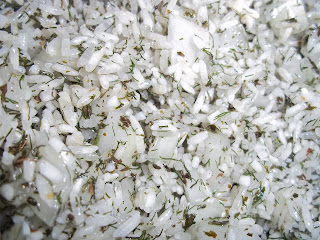
From this grape arbor, we had swings hanging, a tire swing, and a hammock. The grape arbor was fun to climb on, and the really daring used it as monkey bars. We built a club house attached to the grape arbor. The grape arbor was useful for a great many things, but the one thing it never was successful at was growing grapes…
Our grape vines grew widely over the grape arbor, but we never got grapes from the vine, despite me or a sibling of mine unrolling bird netting over the arbor every year to attempt to protect the fledgling grapes from the birds…
The one thing our grape vine actually did provide us with was grape leaves. Every year, my siblings and I would pick a whole bunch of grape leaves, which my mom would then stuff with us. My mom’s recipe for grape leaves is from an Armenian cookbook (whose name I don’t know, or I would credit it), and unlike the more famous stuffed grape leaves, don’t contain either meat or pine nuts, which makes them much cheaper than the standard ones.
Now I no longer have a grape vine in my backyard, but I go foraging and pick grape leaves from some communal grape vines in my community, which I then stuff using my mom’s recipe. Grapes vines are one of those foods that even the novice foragers should be able to forage, as the woody stem, 5 pointed veined leaves, tendrils, and grapes make them hard to mistaken for something else. Not only can you forage typical grapes, but there also are wild grapes that you can forage in certain parts of the world. Here are a few different pages about different types of wild grapes that you can forage, though I have to admit that I’ve never used truly wild varieties for stuffing, only cultivated grape leaves. However the leaves of the wild variety are also edible, and I suspect they would work the same as the cultivated variety.
Why forage grape leaves?
Well, firstly, because they’re free. As are all foraged food.
Secondly, because they’re just yummy. Grape leaves have a lemony taste to them that is pleasant when mixed with other flavors, like as one of many types of greens in a salad.
Thirdly, because they’re pretty darn nutritious. Vitamins C, E, A, K and B6, niacin, iron, fiber, riboflavin, folate, calcium, magnesium, copper and manganese are just some of the many nutrients they contain.
Fourthly, because then you can make this fancy looking dish and pay nearly nothing, having cheapo fancy food.
And guess what? Many, many people I know have access to fresh grapes from a grape vine, either their own vine or a neighbors’ vine (picked with permission, of course), but for those of you who don’t, you can buy jarred grape leaves in the grocery store to use to make these stuffed grape leaves. So this recipe isn’t just for the foragers among us, though we foragers can make it more cheaply.
Here’s how you can make really delicious stuffed grape leaves pretty cheaply. Fancy and cheapskate- you know that’s something I love!
Homemade Vegan Stuffed Grape Leaves
Ingredients:
A bunch of grape leaves. At least 40.
1 large onion
1/2 cup lemon juice
2 cups raw white rice
1 1/8 teaspoon salt
1/8 cup oil
3 tablespoons dried dill or 1/2 cup fresh
1 tablespoon dried mint or 2 tablespoons fresh
Instructions:
1. Chop up your onion finely. Chop up fresh herbs if using.
2. Mix your onion with all the ingredients other than the grape leaves. Your mixture should look something like this.
6. Take a spoonful of the rice mixture, and place it in a straight line as shown in the picture below. I used a lot of filling in that one- you can use less filling to make smaller grape leaves.
7. Fold over both sides of the grape leaf to meet in the middle, and slightly overlapping each other.
8. Start rolling up the leaf from the bottom end facing you.
11. Roll more grape leaves and put the finished leaves around the inside perimeter of the pot.
16. Put water in the pot, enough to cover the whole thing, and to cover the plate partially.
17. If you see the plate isn’t heavy enough, and that the stuffed grape leaves are floating up, put an overturned bowl on top of the plate, and fill it with water to weigh the stuffed grape leaves down some more.
18. Bring to a boil, then cook on a low flame for an hour to an hour and a half, or until all (or almost all) the water is absorbed, and the rice in the stuffed grape leaves is completely, completely soft.





















